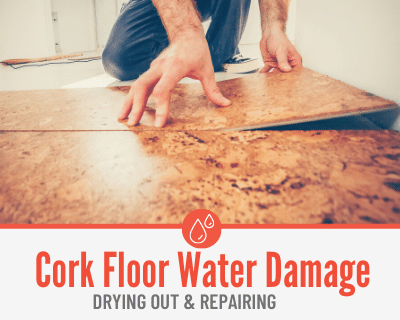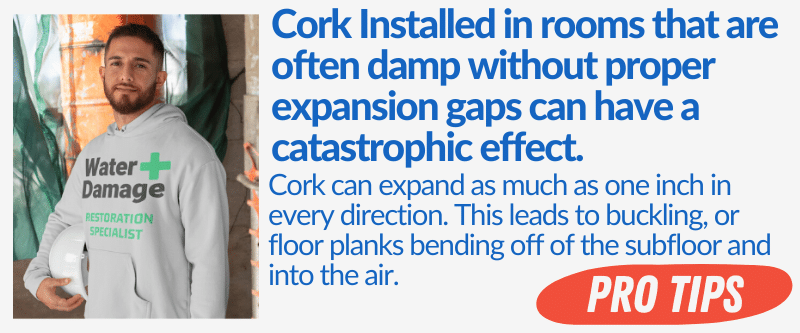Did your Cork Flooring Got Wet? Wondering what can be done to save it?
In this guide you will learn:
- What Happens if your Cork Flooring Gets wet,
- Signs of Water-damaged Cork Flooring ,
- How to Dry out Your Cork Floor and Repair any water Damage,
- How to Protect your Cork Flooring from water.

If you’re looking for help with cork floor water damage then look no further.
Is Cork Flooring Water Resistant?
In general, cork flooring is much better when it comes to dealing with water than other types of wood floorings if it has been properly installed and waterproofed.
However, that does not mean you should leave spills laying on the ground to clean up later.
If there’s water damage to your cork flooring you’ll want to take action fast!
You should try to clean up any liquids as fast as possible.
This is because, while cork does have a fairly good amount of water resistance it is still susceptible to long term water damage.
Depending on the type of cork and how it was installed it may have a higher resistance level but ultimately can still break down and get stained over time.
While cork flooring can be a great choice as flooring, it is not totally water-resistant and you will still need to maintain and care for it just like any other type of flooring.
What happens if Cork Flooring Gets Wet?
Poorly protected cork floors that haven’t been properly sealed will be able to soak up some amount of water.
Depending on how your cork flooring has been installed, this can cause your cork flooring to warp & Lift up.
If you are dealing with a Grey-water leak, this can also cause your cork flooring to stain.
What’s more, if any moisture gets underneath the flooring itself, the glue keeping the cork stuck to the ground will loosen
As you can see, a wet cork floor can mean serious damage.
The good news however is that Cork is naturally antimicrobial and is excellent at resisting mold and mildew formation.

Water absorption of Cork Floors
Cork itself is made up of a substance known as suberin which helps the wood repel water. But this does not stop the absorption of water completely.
If cork flooring is in a moist environment for a long time or is subject to uncleaned spills the natural openings in the wood will make the floor swell and gain weight.
What are the Signs of Water Damaged Cork Flooring?
A cork floor that has been damaged by water is very easy to spot. The floor itself will be warped and some sections may look like they’re lifting up from the floor.
In addition to this, there may be some noticeable discoloration, cracks, or general disintegration of the wood.
- Warping- This happens when water or moisture gets underneath the cork floorboards themselves.
- Discoloration– This happens when any kind of liquid has been absorbed by the cork wood, it could be a sign of mold.
- Disintegration- This is a sign that the water damage has gone too far into cork. At this point the wood floor might not be repairable.
If you think your cork floor is damaged and you need help, be sure to call a professional.
Water Damaged Cork Flooring?
Call 844-488-0570 for a Risk Free estimate from a Licensed Water Damaged Floor Restoration Specialist in your area.
We Can Help Dry out & Repair Your Cork Flooring
How to Dry Out Cork Flooring
Depending on how wet the floor is and where you need to get out the moisture, there are several ways you can try drying your cork floor:
- Step 1: Use a towel
If you are trying to clean up a fresh spill or leak that has gotten on the floor, the easiest and fastest way is to grab a towel or other absorbable item to soak up all the excess liquid. Getting any moisture out as soon as possible is the best way to prevent any permanent water damage.
- Step 2: Get a blow dryer or fan
If you have a blow dryer handy that can reach the liquid, plug it in and use it to blow away any noticeable moisture. If you don’t have a blow dryer, a common household fan should also help if you can position it close enough.
- Step 3: Use a Wet Vacuum
Another common household item that would work well here is a vacuum. In general, a vacuum will work the same way that a fan or blow dryer would but it can actually suck up any liquid rather than simply drying it out.
- Step 4: Control the environment
In order to lessen the effects of any future water damage, take steps to ensure your cork floor is kept as pristine as possible. Make sure that your home is well ventilated and prepared to withstand any outside humidity.
In addition, you can try buying a de-humidifier to keep the area dry and cool.
How to Repair Water Damaged Cork Flooring
In the event your cork floor does have permanent water damage, you may be able to repair it on your own if you follow these simple steps:
If the water damage is confined to a small area, you may be able to simply patch it up using wood filler.
- Find a tool to cut or scrape out the part of the floor that is water damaged.
- Pack the wood filler into the hole in the damaged floor. Make sure your wood filler is the same color as your floor.
- Once the wood filler has been packed, rub it down with sandpaper to smooth out the area.
- Finally, cover the area with a protective finisher to make sure the patch looks the same as the rest of the floor.
If the damage to your Cork floor is widespread however, you may have to replace whole planks or tiles in your cork floor instead:
- When removing cork tiles, you simply need a knife or hammer and chisel to carve out the tile from the floor. When removing planks, you will need to remove the baseboard first.
- Scrape away any residue and leftover adhesive underneath the cork. If replacing a plank, simply remove each plank by hand until you get to the area where the damage is.
- Once the old cork planks or tiles are removed the next part is putting in the new ones. Before putting in a new cork tile, make sure it’s measured correctly and lay down new adhesive where it’s supposed to go. If putting in a new plank, simply place it in by hand and then put back all the other removed planks until you get to the baseboard.
- Just like with repairing a patch, you will finally need to paint over the repaired area with a layer of protective finisher to complete the job.
How Do you Protect a Cork Floor from Water Damage?
Protecting a cork floor can be fairly easy. Before anything, simply make sure to be careful around it and don’t install the cork anywhere that might be too moist or humid.
In addition to this, do not clean the floor with anything that uses a heavy amount of moisture such as a steam mop.
Whenever a cork floor is installed, one of the first things you’ll want to do is seal it with a polyurethane protector which will prevent any water or other liquids from seeping into the pores of the wood and creating lasting damage.
Do you have to Seal cork Floors?
Yes, sealing a cork floor with a protecting coat of polyurethane is essential to keeping your cork floor safe and dry. If you’re looking for help to seal a cork floor or you’re looking for other alternatives to the standard polyurethane mix, you may want to call a professional.
When to call a professional?
Cork floorings can become permanently damaged by moisture if the water isn’t removed and moisture dried out as soon as possible.
If you have a Flood situation with a lot of water to deal with, and the water might even have got under your cork flooring it would be wise to contact a Water Damage Restoration company immediately.
They have the equipment to dry out Large amounts of water from Cork flooring and under it – before your cork flooring gets ruined and needs to be Completely Replaced!
They can also repair any water damage to your Cork flooring if the water has had a chance to Swell it up and Deform its structure.
We have Water Damage Restoration Technicians that can help Remove any Moisture from your Cork Flooring and Repair any Water Damage.
For Disasters of all Sizes,available in 95% of the USA
